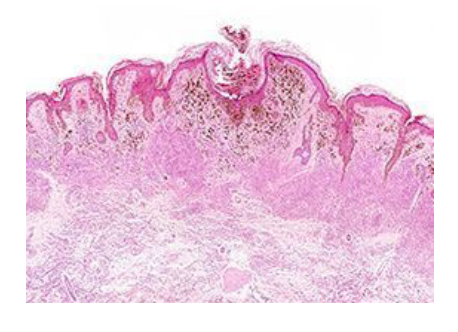Article
STP705 Achieves High Rates of Histological Clearance in Squamous Cell Skin Cancer
Author(s):
The small interfering RNA therapeutic STP705 has been found to induce high rates of histological clearance with a favorable toxicity profile in patients with squamous cell skin cancer.

The small interfering RNA therapeutic STP705 has been found to induce high rates of histological clearance with a favorable toxicity profile in patients with squamous cell skin cancer, according to data from a phase 2a trial (NCT04293679).1
Results from an analysis of 5 groups demonstrated a distinct dosage-dependent efficacy curve in 76% of all patients (n = 19/25) who experienced complete histological clearance. Additionally, those who received the 2 optimal dosing ranges examined were found to have a 90% histological clearance of tumor cell in the lesion.
“This marks a significant milestone as evidenced by the number of patients treated with STP705 for squamous cell skin cancer achieving the primary end point in a dose dependent manner,” Patrick Lu, PhD, the founder, president, and CEO of Sirnaomics, stated in a press release. “The readout not only demonstrates the potential of RNAi therapeutics in oncology, but also illustrates the safety and efficacy of polypeptide nanoparticle formulation of siRNA therapeutics.”
Lu added that the favorable gene silencing data confirms TGF-β1 and COX-2 as significant cancer drug targets and the dual-targeting approach for novel RNAi cancer therapeutics.
The open-label, dose-escalation trial examined the safety and efficacy of an intralesional injection of STP705 in adult patients with cutaneous squamous cell carcinoma in situ, which had been confirmed via biopsy samples. The key objective of the research was to identify the recommended dose of the agent that was both safe and effective in this patient population. Investigators also wanted to evaluate potential biomarker that are common to important the formation pathways TGF-β1 and COX-2.
In the trial, 5 dose-escalation cohorts were evaluated; these 5-patient cohorts received the agent at 10 μg, 20 μg, 30 μg, 60 μg, and 120 μg.2 The enrollment of the first 2 patients in each cohort was staggered by at least 48 hours. Those in the first cohort visited the study center once weekly for an injection of the agent into the lesion. A total of 25 participants were enrolled to the trial and they received injection of STP705 once weekly for up to 6 weeks.
At each visit, investigators evaluated the tumor for clinical changes and reduction in size. If complete clinical clearance of the tumor was observed during the 6 weeks of treatment, the therapy was discontinued. At the end-of-treatment visit, investigators excised the residual tumor or former tumor location for further assessment. If patients did not experience any dose-limiting toxicities, then subsequent cohorts were given increasing doses of the product, following the same schedule as the first cohort examined.
The primary end point of the trial was to examine participants for complete histological clearance of the tumor cells within the treated lesion. Key secondary end points comprised time to histological clearance of treated cutaneous squamous cell carcinoma in situ skin cancer lesion over the treatment period of 6 weeks, the percentage of patients who had complete clinical clearance of treated lesion per investigator evaluation at the end of treatment, time to complete clinical clearance of treated lesion per investigator assessment over the treatment period, and the change in size of the treated lesion of the treatment period.
Additional data from an exploratory immunohistochemistry analysis of pre- and post-treatment tissues from the trial showed that there was significant inhibition of the target gene, TGF-β1 and COX-2, and expression and downregulation of various biomarkers associated with the cancer, such as Ki67, NF-kB, β-Catenin. Increased permeation of CD8+ and CD4+ T cells was also reported within the tumor lesion that received treatment with the product, thus supporting the role of TGF-β1.
With regard to safety, no significant treatment-related toxicities were reported, nor were any serious adverse effects. Moreover, notably, no significant cutaneous skin reactions were observed in the groups of patients who received the treatment. The pharmaceutical company was able to describe a clear therapeutic window, according to the release.
“This is a landmark study for Sirnaomics, as we were able to achieve high rates of histological clearance, which is the gold standard for skin cancer. This was combined with an excellent safety profile and a lack of local cutaneous skin reactions, which is very important to both patients and clinicians as they look for alternatives to surgical excision of these lesions,” Michael Molyneaux, MD, chief medical officer of Sirnaomics, added in the release. “The fact that we were able to demonstrate target gene knockdown along with reduction in important downstream biomarkers makes the results more impactful as we advance into later-stage trials and prepare for potential commercialization.”
The pharmaceutical company announced plans to launch a phase 2b trial of the agent in this patient population, based on the positive results reported from this trial. Moreover, other studies will evaluate STP705 in superficial basal cell carcinoma, hypertrophic scar, keloid scarless healing and liver cancers.
Detailed data from the trial will be submitted for presentation at an upcoming medical conference and for publication.
References
- Sirnaomics reports positive data from phase 2a study of STP705 for treatment of squamous cell skin cancer. News release. Sirnaomics, Inc. December 20, 2020. Accessed December 21, 2020. http://prn.to/3nKUbGo.
- Open-label, dose escalation study for the safety and efficacy of STP705 in adult patients with isSCC. ClinicalTrials.gov. Updated December 11, 2020. Accessed December 21, 2020. https://clinicaltrials.gov/ct2/show/NCT04293679.








